12 Best Home Automation Systems for Luxury Homes in 2025

Transforming Luxury Living: Exploring the Top Home Automation Systems
Building a truly luxurious home now involves more than just premium finishes. It demands intelligent integration of technology. This listicle explores the best home automation systems in 2025, guiding you through the options for a seamless and sophisticated smart home experience. We'll cut through the marketing jargon to give you real-world insights, practical applications, and honest assessments of the top contenders. Whether you’re building a new luxury residence, renovating an existing property, or simply seeking a more convenient and efficient lifestyle, this guide will help you choose the best home automation system for your individual needs.
This in-depth review covers twelve leading systems:
- Google Nest
- Amazon Alexa
- Apple HomeKit
- Samsung SmartThings
- Philips Hue
- Control4
- Home Assistant
- Aqara Hub M3
- Wink Hub 2
- Hubitat Elevation
- Lutron Caséta
- Philips Dynalite
From established giants like Google Nest and Amazon Alexa to specialized platforms like Control4 and Lutron Caséta, we cover a diverse range of options. We examine key features, discuss practical use cases within a luxury home setting, analyze their strengths and weaknesses, and provide specific implementation guidance. This article goes beyond simple product descriptions to offer genuine insights gleaned from extensive usage. You'll discover which system shines in specific scenarios, understand their limitations, and learn how to optimize each for seamless integration. Find the best home automation system to transform your house into a truly intelligent and luxurious living space.
1. Google Nest
Google Nest provides a robust ecosystem for the modern smart home, seamlessly integrating with Google Assistant. This allows intuitive voice control over a wide variety of devices, making it an attractive option for luxury residences and renovations. Imagine pre-heating your pool with a simple voice command or adjusting the lighting as you enter a room, all managed through the familiar Google interface. For tech-oriented homeowners in Australia, the system's ease of use is a significant draw.

Seamless Integration and Extensive Device Range
One of Nest's strengths lies in its compatibility with over 30,000 third-party smart devices. This extensive range makes it suitable for complex home automation setups, from integrating smart lighting and security systems to controlling energy-efficient appliances. The system connects via Wi-Fi, making installation relatively straightforward in new builds and renovations. Control is managed through the user-friendly Google Home app, allowing homeowners to personalize automation routines and access their smart home remotely.
Considerations for Australian Homeowners
While the Google Home app offers a streamlined experience, Nest's reliance on internet connectivity can be a limitation. A stable internet connection is crucial for consistent performance. Another potential drawback is the restricted compatibility with certain non-Google devices, a factor to consider when choosing appliances for your smart home.
Getting Started with Google Nest
Setting up Google Nest is generally straightforward. The Google Home app guides users through the process of connecting devices and establishing automation routines. For those seeking a bespoke smart home experience, consider consulting a professional installer familiar with integrating Google Nest into larger automation systems. More information and pricing details are available on the Google Store.
2. Amazon Alexa
Amazon Alexa serves as a central hub, providing voice-controlled automation with extensive device compatibility and third-party integrations. This makes it a popular choice for Australian homeowners looking for a versatile and readily expandable best home automation system. Imagine controlling your lights, entertainment, and security systems with simple voice commands, all managed through the familiar Alexa interface. Its affordability and ease of use are major selling points.
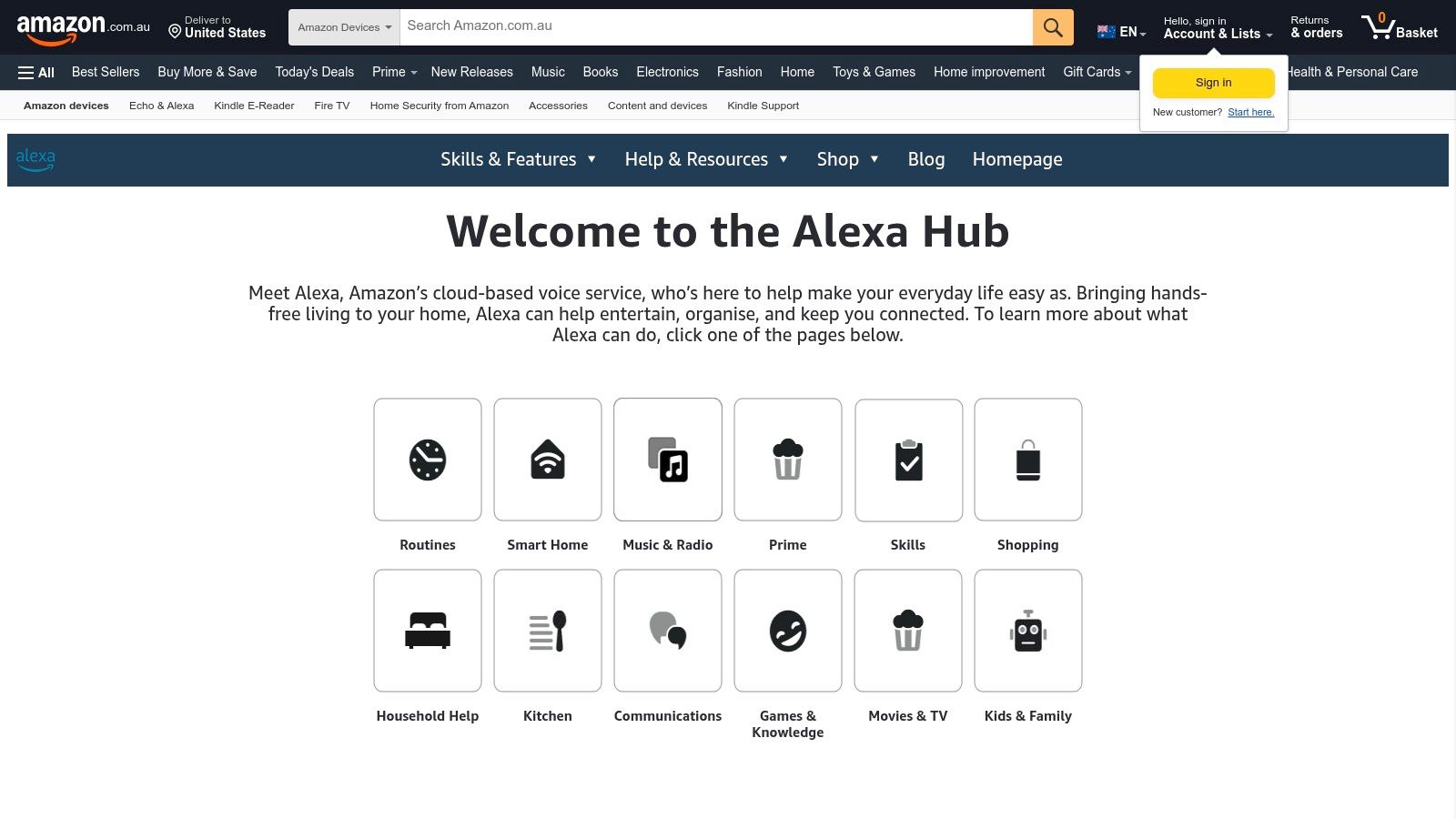
Broad Ecosystem and Voice-First Approach
One of Alexa's strengths lies in its vast compatibility with a wide range of smart home devices. From lighting and thermostats to security cameras and entertainment systems, Alexa can integrate numerous devices into a cohesive system. This is facilitated by Alexa Skills, which are essentially voice-activated apps that extend Alexa's functionality. Control is managed through the Alexa app or via voice commands to an Alexa-enabled device.
Considerations for Australian Homeowners
While Alexa offers broad device compatibility, ensuring your preferred devices are compatible is crucial. A reliable internet connection is essential for seamless operation. Voice control is convenient, but privacy concerns surrounding data collection are a factor to consider. Some advanced features, like more sophisticated home monitoring or guard mode, may require a subscription to services like Alexa Guard Plus.
Getting Started with Amazon Alexa
Setting up Amazon Alexa is straightforward. The Alexa app guides users through the device setup process and connecting smart home devices. Creating routines for automated actions adds another layer of convenience. Explore the Alexa Skills store to find integrations that suit your specific needs. More information and pricing details are available on the Amazon Alexa website.
3. Apple HomeKit
Apple HomeKit provides a secure, privacy-focused platform controlled through Apple devices using Siri and the Home app. This makes it a compelling choice for luxury homeowners prioritizing data security and seamless integration within the Apple ecosystem. Imagine controlling your lighting, security system, and even your garage door with simple voice commands via Siri, all managed through the familiar interface of your iPhone or iPad. For Australian homeowners already invested in Apple products, HomeKit offers an intuitive smart home solution.
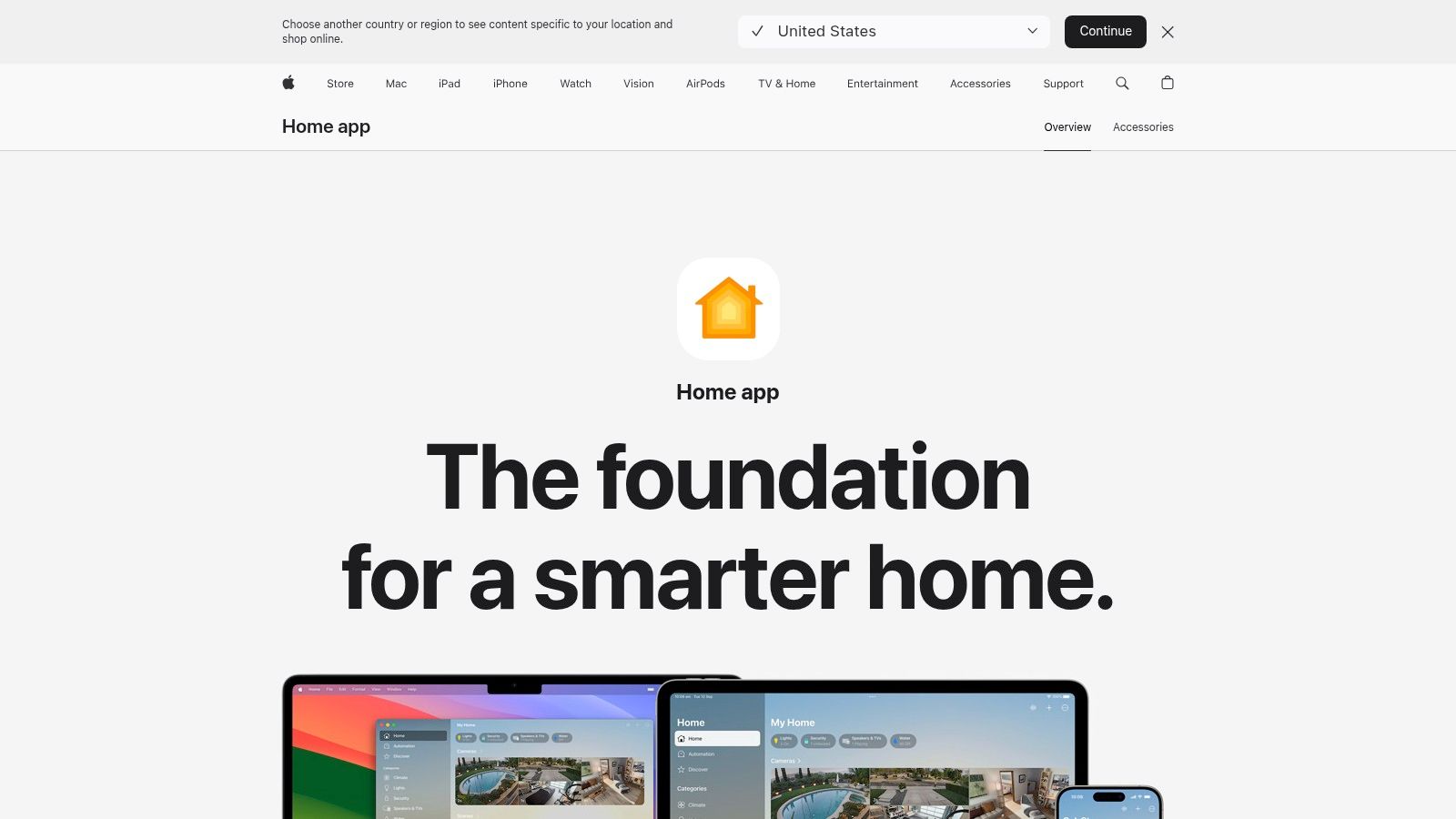
Seamless Integration and Enhanced Security
HomeKit excels in its tight integration with the Apple ecosystem. Control is managed through the user-friendly Home app, available on iPhones, iPads, Macs, and even Apple Watches. The system boasts end-to-end encryption, ensuring your smart home data remains private and secure. This focus on security is a significant advantage for homeowners concerned about data breaches. You can learn more about incorporating Apple HomeKit into your smart home design at Learn more about Apple HomeKit.
Considerations for Australian Homeowners
While the Apple ecosystem provides a polished user experience, HomeKit's biggest drawback is its limited compatibility with non-Apple devices. This restriction can be a significant factor when selecting smart home appliances. HomeKit-certified devices can also be more expensive compared to their non-certified counterparts, potentially increasing the overall cost of your smart home setup.
Getting Started with Apple HomeKit
Setting up Apple HomeKit is relatively simple for users familiar with Apple devices. The Home app guides users through the process of adding HomeKit-compatible accessories and creating personalized automation scenes. However, for more complex integrations within larger automation systems, consulting a professional installer is recommended. More information and pricing details for HomeKit-enabled accessories are available on the Apple website.
4. Samsung SmartThings
Samsung SmartThings offers a versatile platform for creating a truly connected home, especially appealing to Australian homeowners invested in the Samsung ecosystem. Its compatibility with multiple protocols like Zigbee, Z-Wave, and Wi-Fi allows for a broader range of device integration compared to systems locked into a single protocol. Imagine controlling your Samsung appliances, lighting, security system, and even your robot vacuum, all from a single app. Learn more about Samsung SmartThings set up and installation options via our dedicated article.

Flexible Automation and Wide Device Compatibility
SmartThings excels in its flexible automation capabilities. The SmartThings app allows users to create complex routines triggered by various factors, including time of day, location, device status, and even voice commands through integration with virtual assistants. This level of customization is ideal for tailoring the smart home experience to individual preferences, whether it's automating lighting scenes or setting up energy-saving schedules.
Considerations for Australian Consumers
While SmartThings boasts extensive device compatibility, some devices may require additional hubs, adding to the overall cost and complexity. Occasional connectivity issues have been reported, particularly in larger homes with numerous connected devices. Ensuring a strong and reliable Wi-Fi network is crucial for optimal performance. Learn more about Samsung SmartThings.
Getting Started with SmartThings
Setting up SmartThings is generally user-friendly, with the app guiding users through the connection process. The SmartThings Hub acts as the central control point, connecting to your home's Wi-Fi router. From there, adding compatible devices is relatively straightforward. For more complex setups or integrating with existing home automation systems, consulting a professional installer can ensure seamless integration and maximize the potential of the SmartThings platform. Further details and pricing are available on the Samsung website.
5. Philips Hue
Philips Hue specializes in smart lighting, offering millions of color options and voice control integration across various platforms. This makes it a compelling choice for luxury homes where personalized ambiance is key. Imagine dynamically adjusting your lighting to complement artwork, setting the mood for entertaining, or waking up to a simulated sunrise. For design-conscious homeowners, the level of customization is a major selling point.
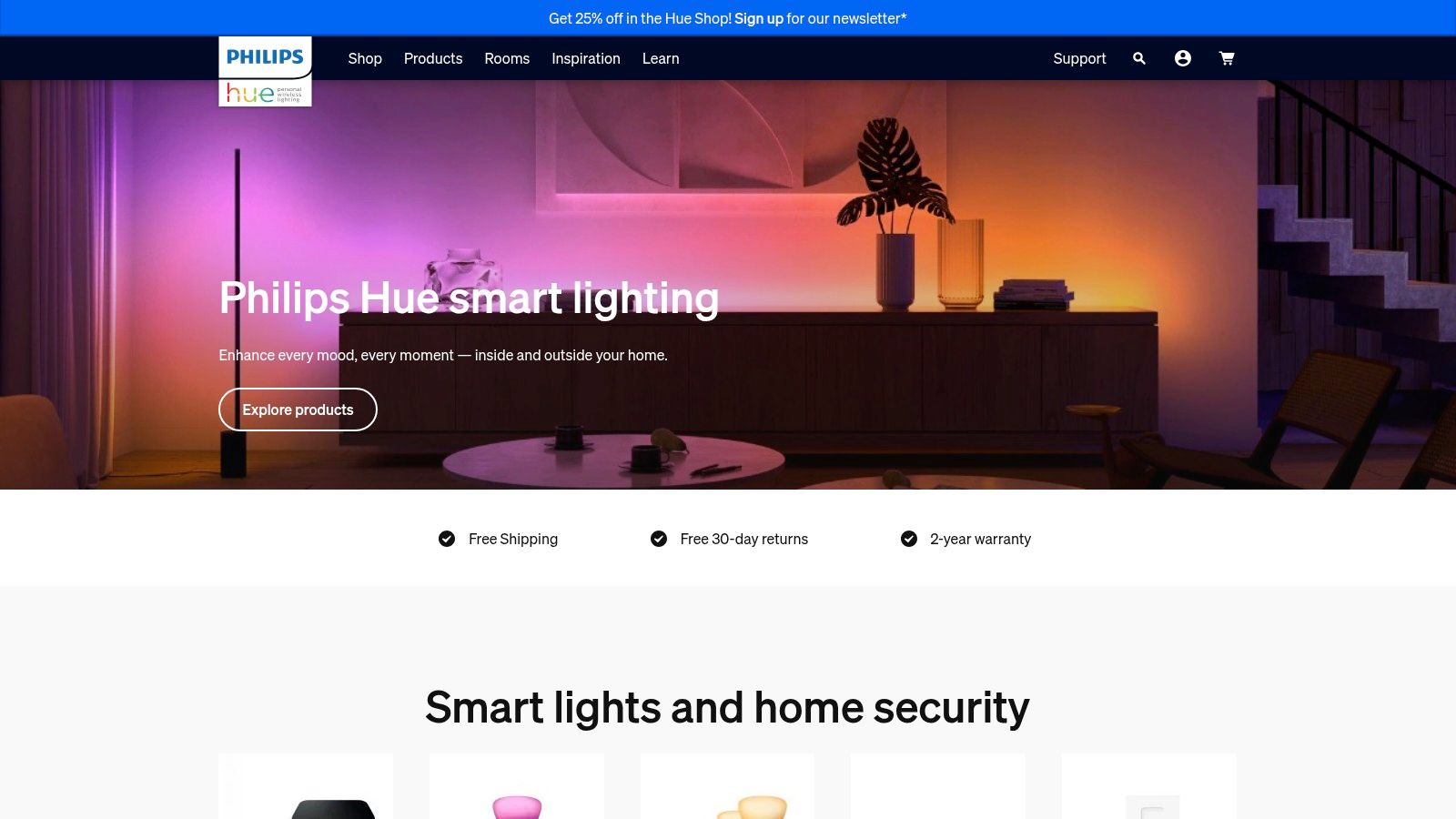
Extensive Customization and Seamless Integration
One of Hue's strengths is its vast array of lighting options. From vibrant colors to subtle shades of white, homeowners can fine-tune their lighting to match any decor or occasion. The system integrates smoothly with popular voice assistants like Google Assistant, Amazon Alexa, and Apple HomeKit, enabling hands-free control. The Philips Hue app provides further automation options, allowing users to schedule lighting changes, create custom scenes, and even sync their lights with music and movies for an immersive entertainment experience. For those interested in home energy monitoring, integrating Philips Hue can provide valuable insights into energy usage. Learn more about Philips Hue and its potential within a comprehensive energy management setup.
Considerations for Australian Homeowners
While Philips Hue offers unparalleled lighting customization, the initial investment can be higher compared to standard bulbs. The system requires a Hue Bridge (hub) for full functionality, adding to the overall cost. However, the long-term benefits of energy efficiency and enhanced home ambiance can offset this initial expense.
Getting Started with Philips Hue
Setting up Philips Hue is relatively simple. The Hue Bridge connects to your home Wi-Fi router, and the Hue app guides users through the process of adding and configuring lights. Consider starting with a starter kit and gradually expanding your system as needed. For complex installations or integration with other smart home systems, consulting a professional installer is recommended. More information and pricing details are available on the Philips Hue website.
6. Control4
Control4 offers a comprehensive and highly customizable home automation system perfect for luxury residences in Australia. It seamlessly integrates lighting, audio, video, climate control, and security into a centralized system. Imagine adjusting the ambient lighting, playing your favourite music throughout the house, and securing the property, all with a single touch on your elegant Control4 interface. For homeowners seeking a truly bespoke and professionally managed smart home, Control4 stands out.
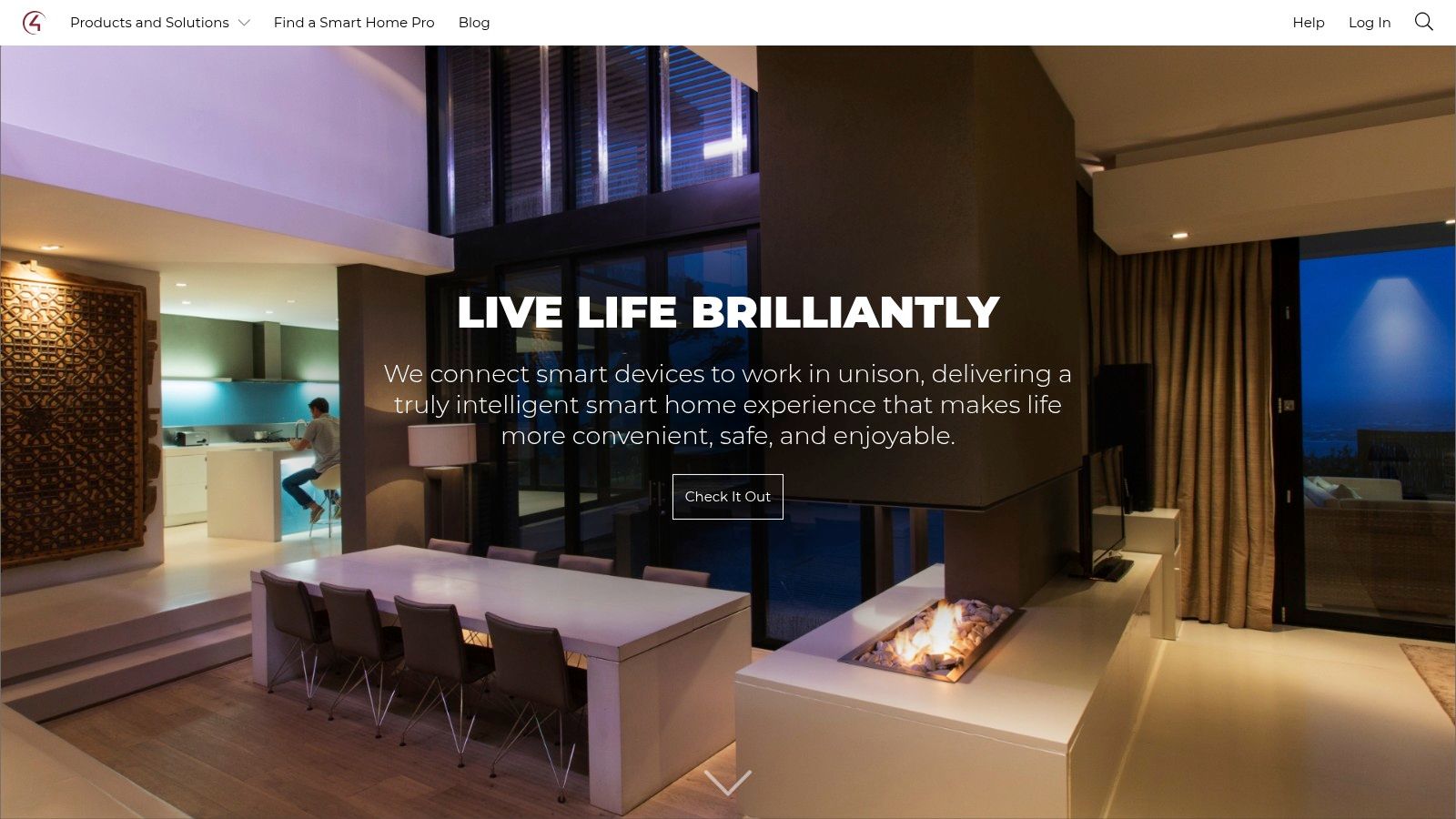
Centralized Control and Professional Reliability
Control4 excels in its ability to manage a wide range of smart devices from over 13,000 third-party manufacturers. This extensive compatibility makes it ideal for complex home automation setups often found in high-end properties. The system relies on professional installation, ensuring reliable performance and seamless integration with existing home infrastructure. This professional approach simplifies setup and maintenance for homeowners. Control is managed through customizable touchscreens, keypads, remotes, or even your smartphone.
Considerations for Australian Homeowners
Control4's professional installation requirement contributes to a higher initial cost compared to DIY systems. However, this investment translates to reliable performance and personalized support. While less suited for DIY enthusiasts, Control4’s tailored approach is a significant advantage for luxury homeowners who value professional service and a seamlessly integrated system. The system can be scaled and adapted to meet the evolving needs of a growing family or changing technology.
Getting Started with Control4
Beginning your Control4 journey starts with contacting a certified dealer in your area. They will assess your home, understand your specific needs, and design a customized system to fit your lifestyle and property. This personalized approach ensures a truly integrated smart home experience. Further information and dealer locations are available on the Control4 website.
7. Home Assistant
Home Assistant offers a powerful, privacy-focused approach to home automation. Unlike cloud-dependent systems, Home Assistant runs locally on your hardware, giving you complete control over your data. This open-source platform excels in its flexibility and extensive device compatibility, making it ideal for tech-savvy homeowners in Australia who desire a truly bespoke smart home experience. Imagine orchestrating complex lighting scenes triggered by sunset or automatically adjusting your home's climate based on real-time energy prices, all managed locally without reliance on external servers. Learn more about Home Assistant.

Unparalleled Customization and Local Control
Home Assistant's strength lies in its open-source nature and vast integration possibilities. It supports thousands of devices, from mainstream smart home brands to niche DIY electronics, allowing for highly customized automation setups. The system operates locally, meaning your data stays within your home network, enhancing privacy and ensuring functionality even without an internet connection. This is particularly attractive for Australian homeowners concerned about data security and internet outages.
Considerations for Australian Homeowners
While incredibly powerful, Home Assistant requires a higher level of technical proficiency. Setting up and maintaining the system involves configuring software and potentially working with command-line interfaces. This steeper learning curve might be daunting for beginners. However, the extensive documentation and vibrant community support can help overcome these challenges.
Getting Started with Home Assistant
Getting started with Home Assistant involves installing the software on a compatible device, such as a Raspberry Pi or a dedicated server. The initial setup process requires some technical knowledge. However, numerous online resources and community forums offer guidance. For those seeking a complex, fully customized smart home, the investment in learning Home Assistant can be highly rewarding. The platform is free and open-source, making it a cost-effective choice for large-scale automation projects.
8. Aqara Hub M3
The Aqara Hub M3 positions itself as a versatile and future-proof hub for the discerning smart home enthusiast. Its compatibility with major ecosystems like Apple HomeKit, Google Home, Amazon Alexa, and Samsung SmartThings makes it a strong contender for best home automation system, especially for Australian homeowners invested in these platforms. The built-in IR blaster adds another layer of control, bridging the gap between modern smart devices and traditional appliances. Imagine controlling your older air conditioning unit alongside your smart lighting, all through a single interface.
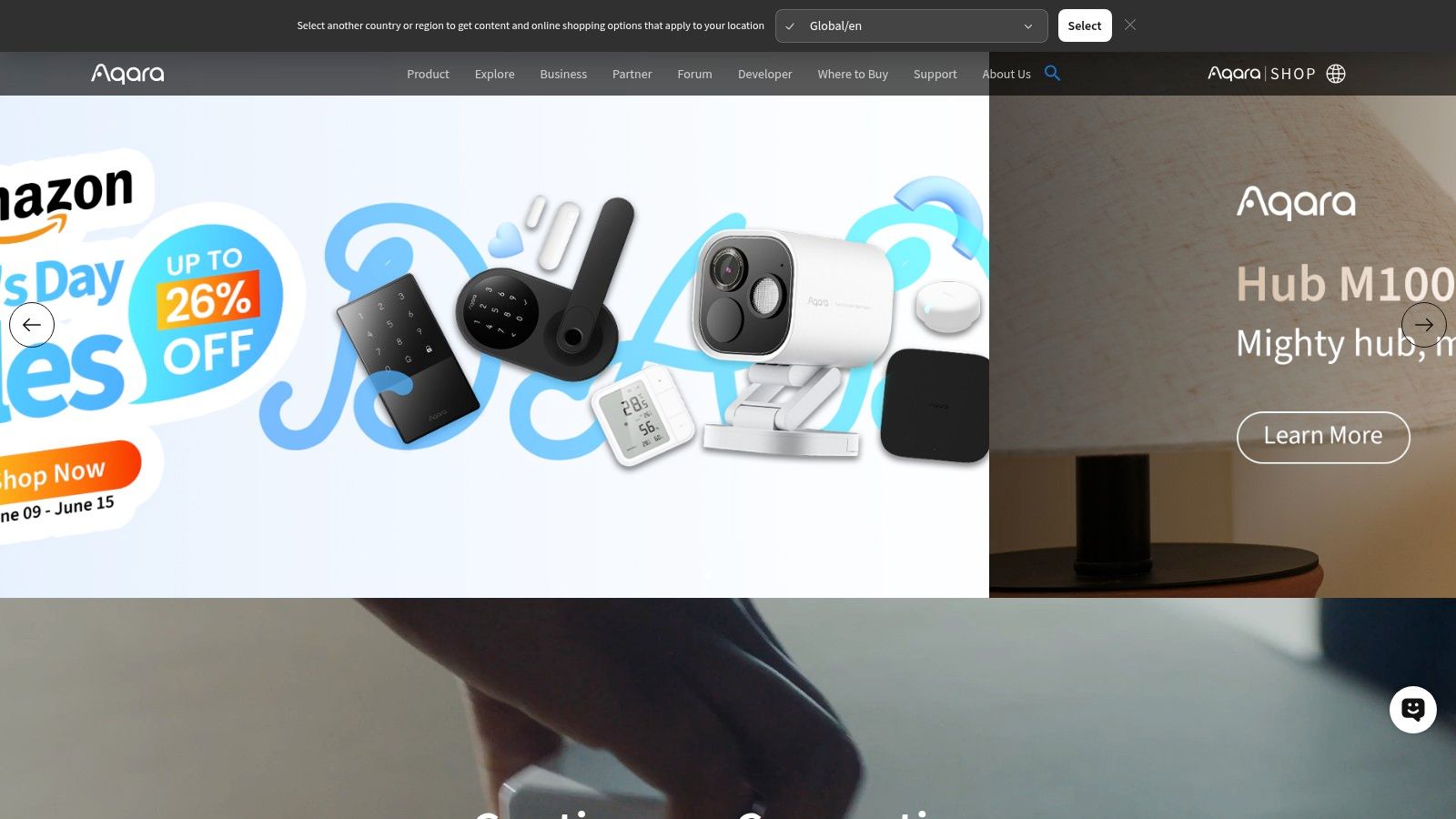
Extensive Ecosystem Compatibility and Future-Proofing
The M3's strength lies in its broad compatibility. Supporting multiple protocols, including the upcoming Matter standard, ensures it remains relevant as smart home technology evolves. This is a significant advantage for homeowners planning long-term investments in their smart home setup. Encrypted local storage adds an extra layer of privacy, addressing growing concerns about data security in connected homes.
Considerations for Australian Homeowners
While the M3 boasts extensive compatibility, its Zigbee support is currently limited to Aqara's own devices. This might restrict flexibility for users heavily invested in other Zigbee-based products. The higher price point compared to some other hubs is also a factor to consider. However, the added features and future-proofing offered by Matter support might justify the investment for those seeking a premium experience.
Getting Started with Aqara Hub M3
Setting up the Aqara Hub M3 is relatively straightforward through the Aqara app. The app guides users through connecting to their chosen ecosystem and adding devices. For complex setups, consulting a professional installer experienced with Aqara products might be beneficial. More information and pricing are available on the Aqara website.
9. Wink Hub 2
Wink Hub 2 stands out as a versatile smart home hub thanks to its broad protocol support. It acts as a central control point for various smart devices, simplifying management and automation through a user-friendly app. This makes it a particularly attractive option for Australian homeowners seeking a flexible and future-proof best home automation system. This hub allows you to connect devices using different wireless technologies, making it easier to integrate various brands and product types.
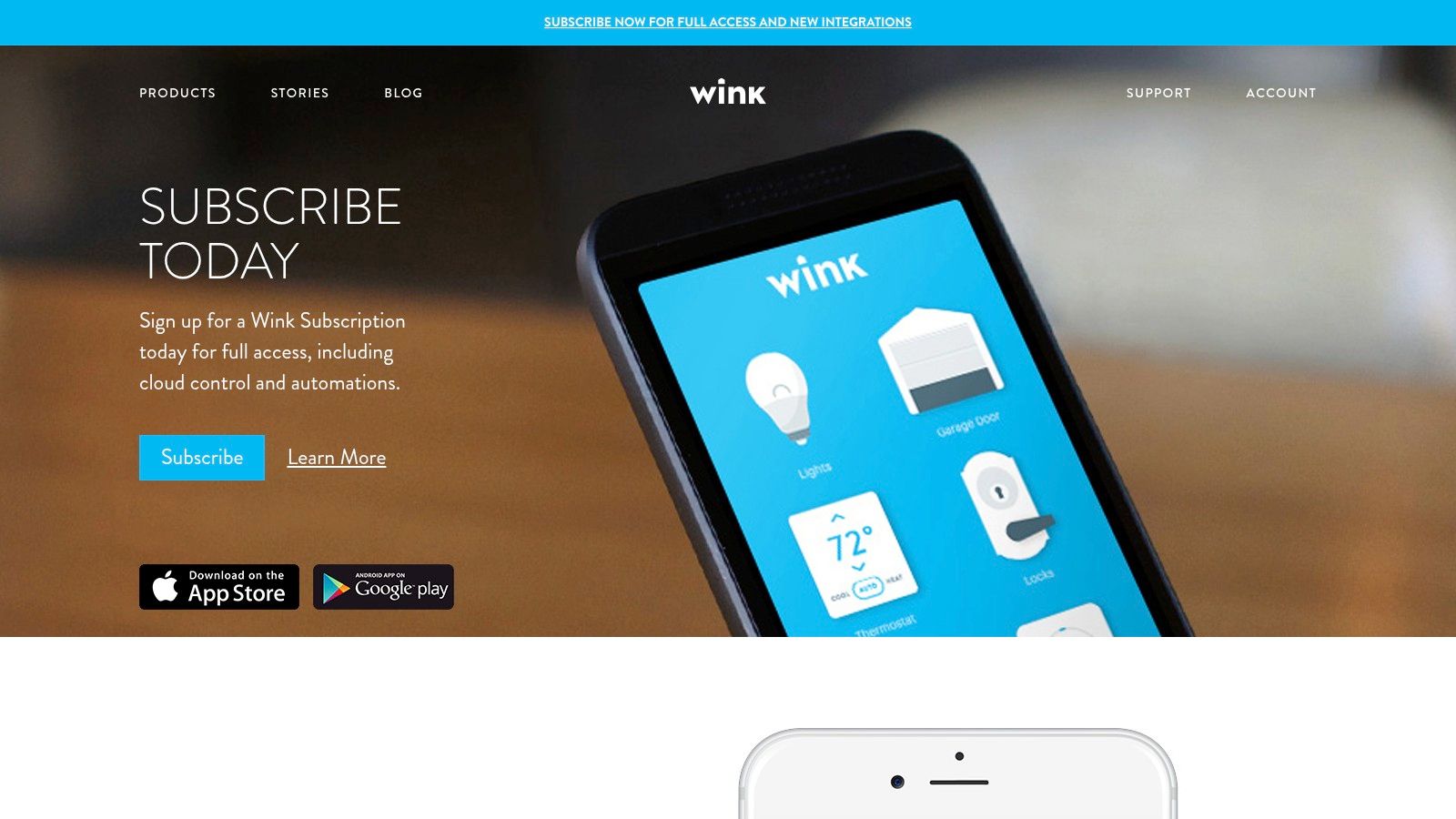
Broad Compatibility and Flexible Automation
Wink Hub 2 supports Zigbee, Z-Wave, Bluetooth, and Wi-Fi, ensuring compatibility with a vast range of smart devices. This flexibility simplifies the integration of various brands and product types within a single ecosystem. From smart lighting and security systems to appliances and entertainment, Wink Hub 2 offers centralized control. Its automation capabilities, powered by IFTTT protocols, further enhance the user experience, allowing for personalized routines and automated responses to various triggers.
Considerations for Australian Users
While Wink Hub 2 excels in device compatibility, its voice control integration is somewhat limited compared to systems like Google Nest or Amazon Alexa. Some advanced features may also require a subscription, a factor to consider when budgeting for your smart home setup. Ensure your chosen devices are compatible with the Wink platform for optimal performance.
Getting Started with Wink Hub 2
Setting up the Wink Hub 2 is generally straightforward. The mobile app guides users through the connection process and device configuration. The hub connects via Ethernet or Wi-Fi, providing flexibility during installation. While the app offers a user-friendly interface for basic automation, exploring IFTTT integration unlocks more complex and customized routines. For more information and to explore compatible devices, visit the Wink website.
10. Hubitat Elevation
Hubitat Elevation offers a different approach to home automation, prioritizing local control and privacy. Unlike cloud-dependent systems, Hubitat processes automation rules locally. This results in faster response times and reduces reliance on internet connectivity, a significant advantage for Australian homeowners in areas with less reliable internet service. It's ideal for those who value data security and want a more responsive smart home.
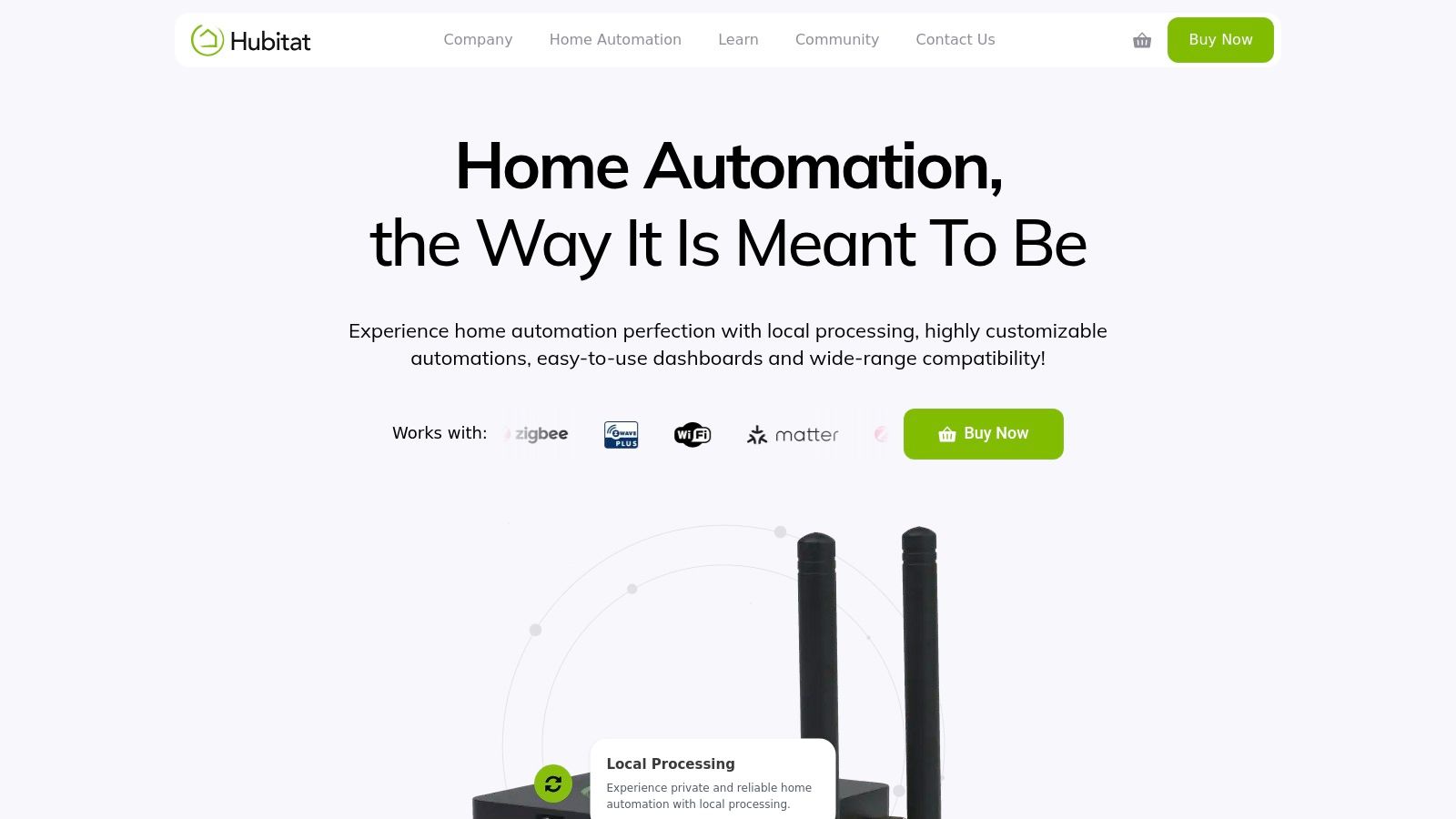
Local Control and Enhanced Privacy
Hubitat's local processing ensures that your smart home data stays within your network. This provides peace of mind for privacy-conscious homeowners. The system boasts compatibility with a wide array of Z-Wave and Zigbee devices, offering flexibility in building your smart home ecosystem. The powerful rule engine allows for complex automations tailored to individual needs.
Considerations for Australian Homeowners
While Hubitat offers excellent control and privacy, it does have a steeper learning curve. Setting up complex automation rules requires some technical proficiency. Native voice control integration is limited, although workarounds exist for integrating with voice assistants. This is a key consideration for those seeking a simple, voice-controlled smart home experience.
Getting Started with Hubitat Elevation
Setting up Hubitat Elevation involves connecting the hub to your network and adding compatible devices. The platform's community forums and extensive documentation are valuable resources. For homeowners seeking complex integrations or advanced automation, consulting a home automation specialist is recommended. More information is available on the Hubitat website.
11. Lutron Caséta
Lutron Caséta specializes in smart lighting control, offering a reliable wireless system for customizable ambiance and convenient automation. This makes it a strong contender for inclusion in any best home automation system list, especially for Australian homeowners prioritizing sophisticated lighting control. Imagine effortlessly adjusting your home's lighting to match your mood or setting automatic schedules to enhance security while you're away, all managed through a user-friendly interface.
Seamless Lighting Control and Broad Compatibility
One of Caséta's key strengths is its robust wireless communication protocol, Clear Connect. This ensures dependable performance and minimizes interference, crucial for reliable automation. The system offers a wide variety of lighting control options, from simple dimmers and switches to advanced scene controllers, allowing for granular control over every light in your home. Furthermore, Caséta integrates with other popular smart home platforms, including Google Assistant and Amazon Alexa, further enhancing its versatility.
Considerations for Australian Homeowners
While Caséta excels at lighting control, it’s important to note its primary focus is illumination. Unlike broader automation systems, its functionality doesn't extend to appliances or security systems in the same comprehensive manner. The initial cost of Caséta can be higher compared to standard switches, though the long-term energy savings and convenience often justify the investment.
Getting Started with Lutron Caséta
Installing Caséta is surprisingly straightforward, even for DIY enthusiasts. The system uses a simple hub that connects to your Wi-Fi router and communicates wirelessly with the switches and dimmers. No complex wiring is required, making it ideal for both new constructions and renovations. For more complex integrations or if you're unsure about the setup process, consulting a professional installer is always a good idea. Further information and pricing can be found on the Lutron website.
12. Philips Dynalite
Philips Dynalite, developed in Australia, offers a professional-grade lighting control and automation system. This system provides scalable solutions perfect for both residential and commercial applications. Its comprehensive features make it a strong contender for luxury homes and renovations, particularly for those seeking granular control over their lighting environment. Imagine effortlessly orchestrating the perfect ambiance for entertaining or waking up to gently increasing light levels - Dynalite delivers this level of control. For discerning Australian homeowners, this system represents a sophisticated approach to home automation.
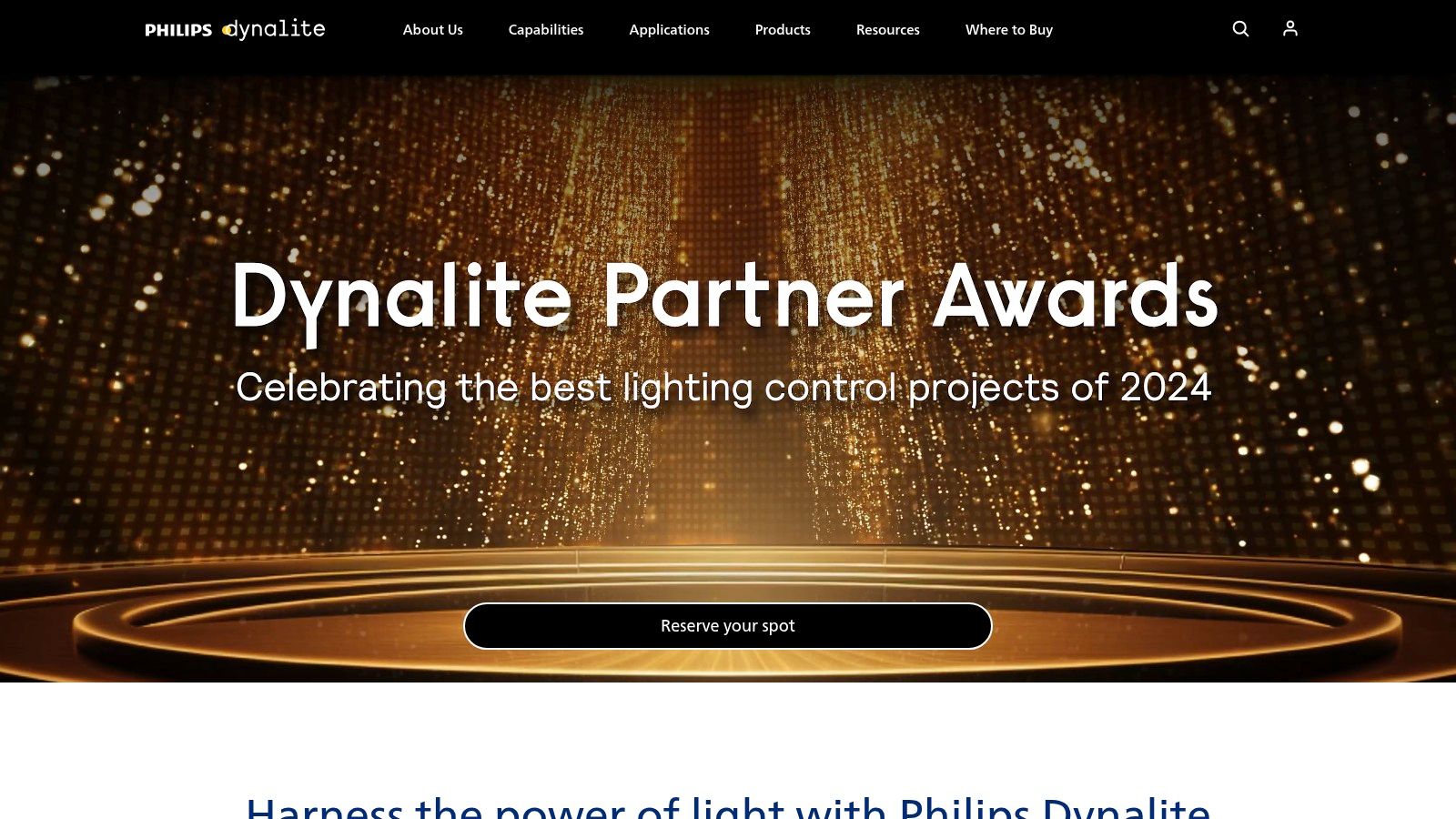
Comprehensive Lighting Control and Scalability
Dynalite excels in its highly customizable and scalable nature. This makes it ideal for integrating into complex home automation setups, especially in larger residences. The system's robust design ensures professional-grade reliability. Its extensive compatibility with various devices allows for seamless integration with existing building management systems, offering a unified control platform.
Considerations for Australian Homeowners
While Dynalite offers unparalleled control and customization, its professional installation requirement translates to a higher upfront cost compared to more DIY-friendly systems. This system is less suited for those seeking a simple, plug-and-play solution. However, for homeowners prioritizing robust, highly customizable lighting control, the investment can be worthwhile.
Getting Started with Philips Dynalite
Due to its complexity, Dynalite installations typically require a certified installer. Consulting a professional ensures proper system design and integration with other smart home components. This personalized approach allows homeowners to tailor the system to their specific needs, creating a truly bespoke automation experience. For more information and to find a certified installer, visit the Philips Dynalite website.
Top 12 Home Automation Systems Comparison
Product | Core Features / Integration | User Experience / Quality ★★★★✩ | Value Proposition 💰 | Target Audience 👥 | Unique Selling Points ✨ | Price Point 💰 |
Google Nest | Wi-Fi, Google Assistant, 30,000+ devices | Easy setup, intuitive UI | Strong Google ecosystem integration | Smart home users, Google fans | Seamless Google service integration | Moderate |
Amazon Alexa | Voice control, Alexa Skills, broad device compatibility | User-friendly voice commands, frequent updates | Wide compatibility, evolving features | Voice automation users, broad audience | Extensive third-party skills ecosystem | Moderate |
Apple HomeKit | Siri integration, strong privacy, growing certified devices | Seamless Apple device integration | High security and privacy | Apple ecosystem users | End-to-end encryption, premium Apple ecosystem | Higher |
Samsung SmartThings | Zigbee, Z-Wave, Wi-Fi support, Samsung device integration | Flexible automation, user-friendly | Broad device support | Samsung users, tech-savvy homeowners | Multi-protocol hub, Samsung appliances compatibility | Moderate |
Philips Hue | Smart lighting, multi-platform voice control | High-quality lighting, customizable | Premium smart lighting system | Lighting enthusiasts, smart home users | Millions of colors, entertainment sync | Higher |
Control4 | Lighting, audio, video, climate, security control | Professional-grade reliability | Fully customizable, professional installation | Luxury smart home market | Extensive device compatibility, pro installation | High |
Home Assistant | Open-source, local control, 1000+ brands | Highly flexible, steep learning curve | Free, privacy-focused | Advanced DIY, privacy-conscious users | Open-source, no cloud dependency | Free |
Aqara Hub M3 | Multi-ecosystem, IR blaster, Matter controller | Enhanced privacy features | Wide compatibility, future-proof | Advanced smart home users | IR blaster, multi-protocol including Matter | Higher |
Wink Hub 2 | Zigbee, Z-Wave, Bluetooth, Wi-Fi | Easy setup, flexible automation | Broad device support | Casual smart home users | Multi-protocol, IFTTT automation | Moderate |
Hubitat Elevation | Local control, fast response, powerful rule engine | Reliable, privacy-focused | Enhanced privacy, no cloud dependency | Privacy-conscious, tech-savvy users | Local automation, strong rule engine | Moderate |
Lutron Caséta | Wireless lighting control, broad system integration | Dependable, easy installation | Focused on lighting control | Homeowners wanting lighting control | Reliable wireless, customizable lighting | Higher |
Philips Dynalite | Scalable lighting control, building integration | Professional-grade, customizable | High-end professional installations | Commercial & luxury residential | Australian-made, integrated building systems | High |
Building Your Dream Smart Home: Key Considerations and Next Steps
Choosing the best home automation system for your Australian luxury home requires careful consideration. From the DIY-friendly systems like Google Nest, Amazon Alexa, and Apple HomeKit to the professionally installed options like Control4 and Lutron Caséta, there's a system for every need and budget. Reflect on the features, pros, and cons we discussed for each platform, prioritizing functionalities that align with your lifestyle. Do you prioritize voice control, smart lighting, or comprehensive security integration? The answers to these questions will guide you towards the perfect system.
Key Takeaways for the Discerning Homeowner
- Integration is Key: Consider how well each system integrates with your existing devices and future plans. A fragmented system can lead to frustration.
- Scalability Matters: Think long-term. As your needs evolve, your system should be able to grow with you, accommodating new devices and functionalities.
- Budget Wisely: Home automation systems can range from a few hundred dollars to tens of thousands. Establish a realistic budget early on.
- Security First: Prioritize systems with robust security features to protect your home and data.
Implementing Your Smart Home Vision: Practical Advice
- Start Small: Begin with a single room or a specific function, such as lighting or security, and gradually expand your system.
- Professional Consultation: For complex projects, consider engaging a professional installer experienced in luxury home automation. Their expertise can save you time, money, and headaches.
- DIY vs. Professional Installation: Assess your technical skills and comfort level. Some systems are designed for DIY installation, while others require professional expertise.
- Future-Proofing: Consider emerging technologies and choose a system that can adapt to future advancements.
Finding the Best Home Automation System in Australia
The "best" home automation system is subjective, depending entirely on your individual needs and priorities. There is no one-size-fits-all solution. If you prioritize simplicity and voice control, Google Nest or Amazon Alexa might be suitable. For Apple users invested in the Apple ecosystem, HomeKit offers seamless integration. For those seeking a high-end, professionally installed system, Control4 or Lutron Caséta are excellent choices. Platforms like Home Assistant cater to tech-savvy users who prefer maximum customization and control.
Ultimately, the ideal system empowers you to effortlessly control your home's environment, enhancing comfort, security, and convenience. From automated lighting and climate control to sophisticated security systems and entertainment integration, a well-implemented smart home system can transform your living experience.
Ready to create your dream smart home in Australia? Envy Abode specializes in designing and installing bespoke automation solutions for luxury residences. Visit Envy Abode to explore how their expert team can bring your smart home vision to life.